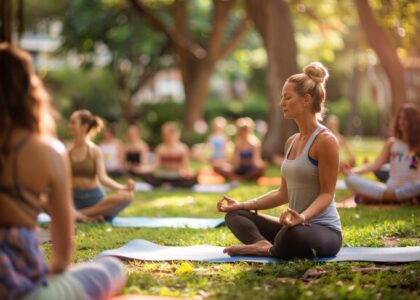In today’s fast-paced world, students face multiple challenges that can lead to stress, anxiety, and burnout. Whether it’s exam pressure, academic deadlines, or the balancing act of personal and school life, students are constantly juggling responsibilities. The good news is that yoga can be an effective tool for managing stress, improving focus, and promoting overall well-being.
In this blog, we’ll explore how Stress Management Yoga can help students reduce stress, enhance concentration, and improve mental health—ultimately making their academic journey more fulfilling and balanced.
1. Yoga Helps Reduce Stress and Anxiety
Stress and anxiety are common emotions that many students experience, especially during exams or assignments. Yoga helps calm the nervous system and activate the body’s relaxation response. Specific breathing techniques (pranayama) and meditative practices are designed to alleviate stress, clear mental clutter, and promote a peaceful state of mind.
Techniques like:
- Nadi Shodhana (Alternate Nostril Breathing): Balances the nervous system, reduces stress, and improves mental clarity.
- Ujjayi Breath: Creates a calming effect and helps regulate emotions.
- Bhramari (Bee Breath): Relieves anxiety and promotes relaxation.
By practicing these techniques, students can effectively manage the overwhelming feelings that come with academic challenges.
2. Yoga Improves Focus and Concentration
One of the key challenges students face is maintaining concentration and focus, especially during long study sessions. Yoga improves mental clarity by fostering mindfulness and present-moment awareness. The focus required in yoga asanas (postures) translates into a sharper and more focused mind in academic tasks.
Asanas such as Tree Pose (Vrksasana), Warrior Pose (Virabhadrasana), and Seated Forward Bend (Paschimottanasana) help cultivate concentration and improve attention span, both crucial for effective studying.
Yoga also teaches students to stay in the moment, which can help them avoid distractions and focus on the task at hand, whether it’s studying for a test or completing assignments.
3. Yoga Reduces Physical Tension and Fatigue
Long hours of studying, sitting in front of computers, or attending classes can take a toll on the body, causing neck, shoulder, and back pain. Physical tension can exacerbate mental stress, creating a cycle of discomfort and anxiety. Yoga can release this built-up tension and help students feel physically refreshed.
Yoga poses such as:
- Child’s Pose (Balasana): Gently stretches the back and hips, helping to release tension.
- Cat-Cow Pose (Marjaryasana-Bitilasana): Relieves neck and back tension.
- Downward-Facing Dog (Adho Mukha Svanasana): Helps alleviate stiffness in the back and shoulders.
These poses improve posture, alleviate physical discomfort, and promote relaxation, which can enhance overall energy levels.
4. Yoga Enhances Emotional Well-being
Emotional well-being is vital for managing stress, and yoga offers numerous benefits for emotional health. By incorporating mindfulness and self-compassion into their practice, students can improve their emotional resilience. Yoga allows students to process emotions in a healthy way, which helps with emotional regulation and reduces feelings of anger, frustration, or sadness.
Incorporating meditation and mindful breathing during or after yoga can help students stay calm and centered, improving emotional stability.
Mindfulness techniques such as:
- Body Scan Meditation: Helps release stored tension and promotes a feeling of calm.
- Loving-kindness meditation: Fosters positive emotions, self-love, and compassion.
These practices encourage emotional balance, allowing students to deal with challenges in a more constructive way.
5. Yoga Supports Healthy Sleep Patterns
Stress and anxiety often interfere with a student’s ability to get a good night’s sleep, leading to tiredness and reduced academic performance. Poor sleep can result in irritability, difficulty focusing, and even more stress. Yoga, particularly gentle yoga practices before bedtime, can help students relax and prepare for restful sleep.
Gentle poses such as:
- Legs Up the Wall Pose (Viparita Karani): Calms the nervous system and promotes relaxation.
- Savasana (Corpse Pose): Relaxes the body completely and relieves tension.
- Supta Baddha Konasana: Opens the hips and relaxes the body, preparing it for sleep.
By practicing restorative yoga before bed, students can improve their sleep quality, feel more refreshed in the morning, and maintain higher energy levels throughout the day.
6. Yoga Boosts Confidence and Self-Esteem
For students, managing stress is often linked to maintaining confidence and self-esteem. Yoga helps build mental resilience and fosters a positive self-image. As students practice yoga, they develop a sense of self-awareness and self-compassion, which are vital in combating negative thoughts and emotions.
Yoga can help:
- Increase self-awareness: Students become more aware of their body, mind, and emotions, leading to better self-understanding.
- Build resilience: Yoga teaches perseverance and patience, important traits for overcoming academic obstacles.
- Develop positive self-talk: Through mindfulness and meditation, students learn to replace negative thoughts with more constructive and empowering ones.
A positive mindset is a valuable tool for academic success and overall happiness.
7. Yoga Fosters a Balanced Lifestyle
A balanced lifestyle is essential for reducing stress and leading a happy, healthy life. Yoga emphasizes the importance of balance—not just in your physical practice, but in your daily life. By cultivating balance through regular yoga practice, students can manage their academic and personal lives more effectively, leading to better time management, reduced stress, and increased productivity.
Yoga encourages healthy habits, such as regular physical activity, proper nutrition, and mental relaxation, all of which contribute to a more balanced, stress-free lifestyle.
Conclusion
Stress is a common challenge faced by students, but it doesn’t have to be overwhelming. By incorporating stress management yoga into their daily routine, students can learn how to manage their stress, stay focused, and cultivate emotional and physical well-being. Yoga provides students with the tools they need to build mental resilience, improve concentration, release physical tension, and develop a balanced lifestyle—all of which contribute to overall happiness and success in their academic journey.
At Yog Se Nirog, we offer specially designed yoga classes for students to help manage stress and improve their mental and physical well-being. Join us today and discover how yoga can empower you to lead a more balanced, focused, and fulfilling life.




